Introduction
In order to lower feed costs, crystalline AA are used routinely in swine diets to replace a portion of the soybean meal. The AA that are currently available to add to swine diets include lysine, threonine, methionine, tryptophan, and valine. The increased availability of crystalline AA sources has created the opportunity to formulate grain-based diets to the fifth or sixth limiting AA. If this can be accomplished without negatively affecting pig growth performance, it should result in greater economic return. Because AA requirement estimates are now routinely based on standardized ileal digestible (SID) AA ratios relative to Lys, the objective of this experiment was to determine the effects of feeding increasing concentrations of crystalline AA as a replacement for soybean meal in sorghum- or corn-based diets on growth performance and carcass composition of finishing pigs.
Materials and Methods
The Kansas State University Institutional Animal Care and Use Committee approved the experimental procedures and animal care for this study. This experiment was conducted in the finishing facility at the Kansas State University Swine Teaching and Research Center in Manhattan, KS. The facility is a totally enclosed, environmentally controlled, mechanically ventilated barn. Each pen contained a 2-hole, dry self-feeder and a cup waterer to provide ad libitum access to feed and water. Pens (5 × 10 ft) were located over a completely slatted concrete floor.
A total of 288 pigs (PIC 327×1050; initially 101.1 lb) were used in a 90-d study with 8 pigs per pen and 6 pens per treatment. Treatments were arranged in a 2 × 3 factorial with main effects of grain source (sorghum vs. corn) and crystalline AA supplementation (low, medium, or high). The grain sources and soybean meal were analyzed for AA profile and diets formulated from these concentrations (Table 1). Amino acids ratios to Lys as well as standardized ileal digestibility coefficients used were set by NRC (2012). All diets (Tables 2 to 5) were fed in meal form in 4 phases and formulated to the same Lys:NE ratio and at 95% of the pig’s estimated Lys requirement to ensure that AA were not above the pigs’ requirement. The low AA fortification contained L-lysine HCl and DL-methionine. The medium AA fortification contained L-lysine HCl, DL-methionine and L-threonine. The high AA fortification contained L-lysine HCl, DL-methionine, L-threonine, and L-valine in sorghum- or L-tryptophan in corn-based diets.
Pig weight and feed disappearance were measured approximately every 2 wk to determine ADG, ADFI, and F/G. On d 90, all pigs were individually weighed and tattooed for carcass data collection and transported 130 mi. to a commercial packing plant (Triumph Foods LLC, St. Joseph, MO) for collection of standard carcass data and jowl fat iodine value (IV). Jowl fat IV was calculated using near infrared spectroscopy (NIR; Bruker MPA; Multi-Purpose Analyzer). Hot carcass weights were measured immediately after evisceration and each carcass was evaluated for percentage carcass yield, backfat, loin depth, and percentage lean. Fat depth and loin depth were measured with an optical probe inserted approximately 3 in. from the dorsal midline between the 3rd and 4th last rib (counting from the ham end of the carcass). Percentage carcass yield was calculated by dividing HCW at the plant by live weight at the farm.
Feed samples for each dietary treatment were taken at multiple times during the experiment, and sub-sampled for chemical analysis. Feed samples were analyzed for DM, Ca, and P (Ward Laboratories, Inc., Kearney, NE) and for total AA and CP (Ajinomoto Heartland, Inc., Chicago, IL).
Data were analyzed as a randomized complete block design using PROC MIXED in SAS (SAS Institute, Inc., Cary, NC) with pen as the experimental unit. Data were analyzed as a 2 × 3 factorial with interactive and main effects of grain source and AA fortification. In addition, the data were analyzed for linear and quadratic effects of increasing AA concentrations. Results from the experiment were considered significant at P ≤ 0.05 and a tendency between P > 0.05 and ≤ 0.10.
Results and Discussion
Results of diet analysis were similar to formulated values (Tables 6 and 7). Overall, no grain source × crystalline AA interactions were observed (Table 8). Pigs fed cornbased diets tended to have greater ADG (P < 0.072) and had better F/G (P < 0.01) than those fed sorghum-based diets. As crystalline AA concentrations increased, ADG tended to increase then decrease (quadratic; P = 0.057), ADFI decreased (linear; P = 0.019), and F/G tended to improve to the medium AA fortification level and then became poorer at the highest AA fortification (quadratic; P = 0.097). Pigs fed cornbased diets tended to have greater loin depth (P = 0.088) and increased (P < 0.01) jowl fat IV compared to pigs fed sorghum-based diets. Increasing crystalline AA fortification did not influence any carcass characteristic.
In conclusion, these data suggest corn-based diets will improve performance compared to sorghum-based diets with the feeding value of sorghum being 97% compared to corn, based on F/G. At the high addition of crystalline AA, ADG, but not F/G worsened, suggesting these diets were deficient in a different AA or nutrient needed to support maximum growth performance. Additional research should be conducted to determine proper diet formulation strategies needed to maximize growth performance of pigs when high levels of crystalline AA are included in the diets.
This article was originally published in Kansas Agricultural Experiment Station Research Reports: Vol. 1: Iss. 7. https://doi.org/10.4148/2378-5977.1117. This is an Open Access article licensed under a Creative Commons Attribution 4.0 License. Table 1. Analyzed AA concentration of sorghum, corn, and soybean meal (%, as-fed basis)1
Table 2. Phase 1 diet composition (as-fed basis)1
Table 3. Phase 2 diet composition (as-fed basis)1
Table 4. Phase 3 diet composition (as-fed basis)1
Table 5. Phase 4 diet composition (as-fed basis)1
Table 6. Chemical analysis of experimental diets Phase 1 and 2 (as-fed basis)1
Table 7. Chemical analysis of experimental diets Phase 3 and 4 (as-fed basis)1
Table 8. Interactive effects of grain source and crystalline AA level on growth performance and carcass characteristics of finishing pigs1
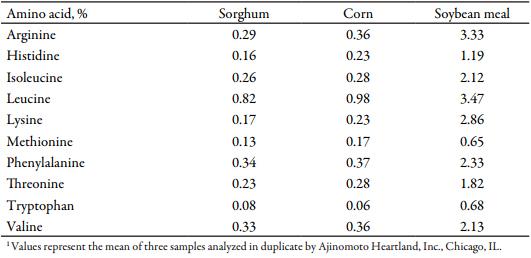
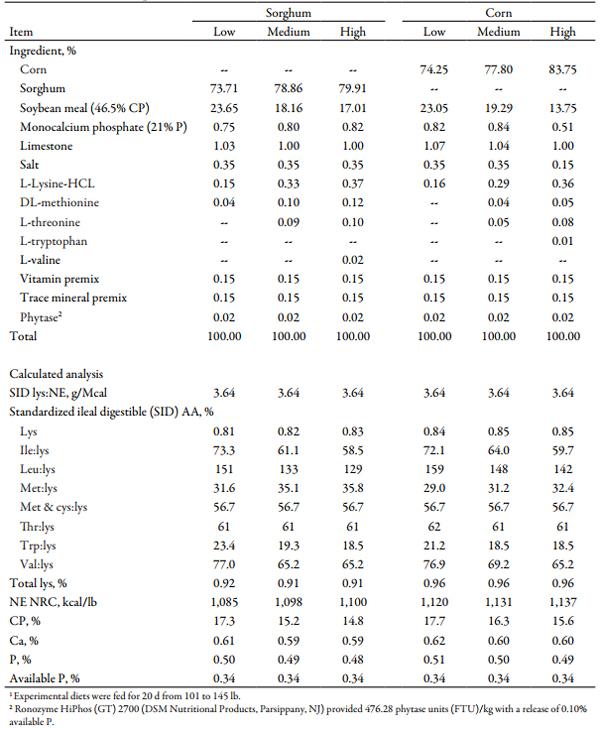

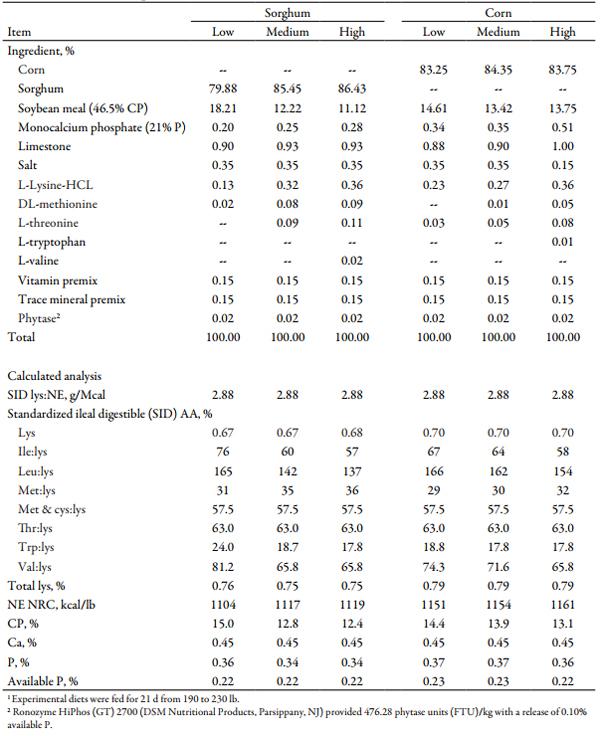
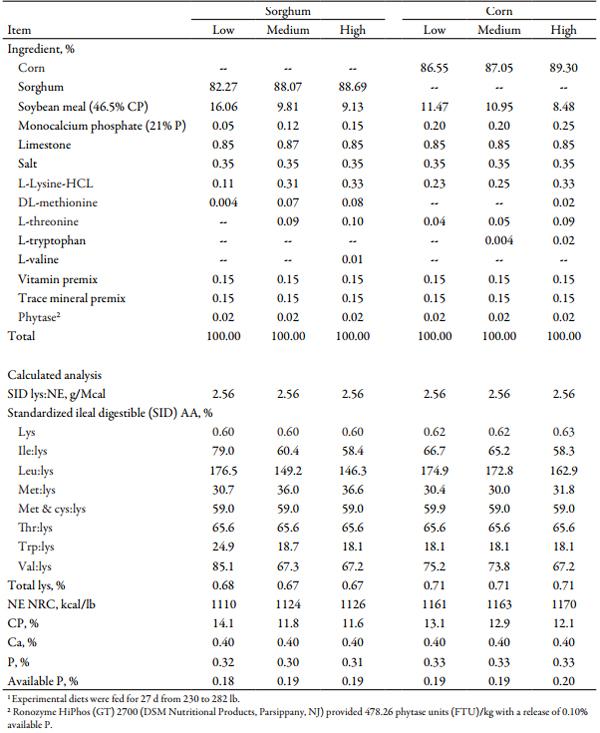

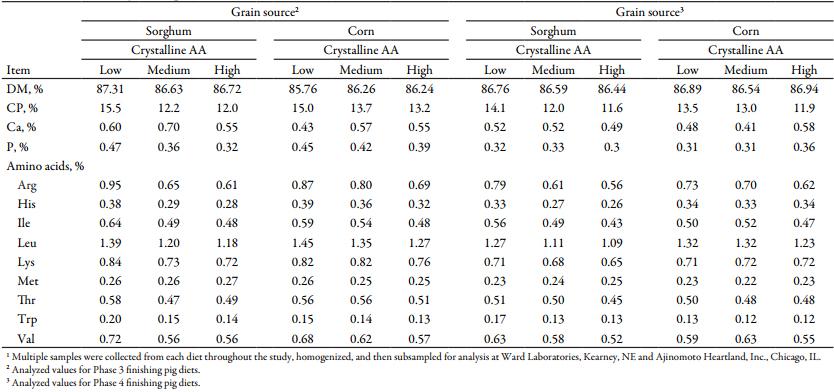
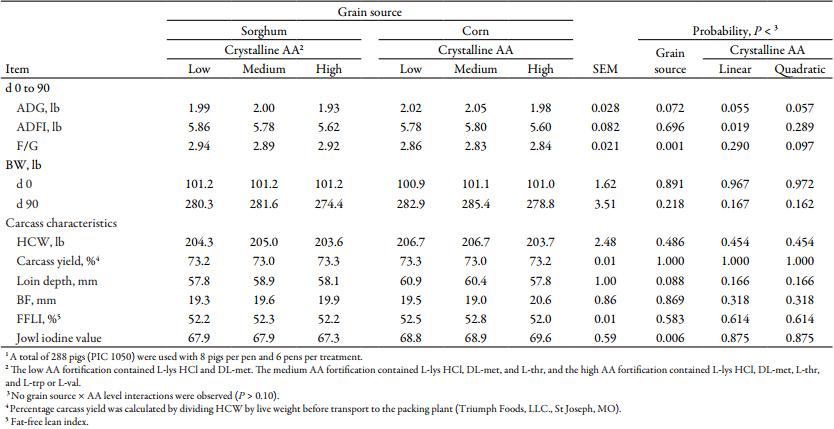









.jpg&w=3840&q=75)